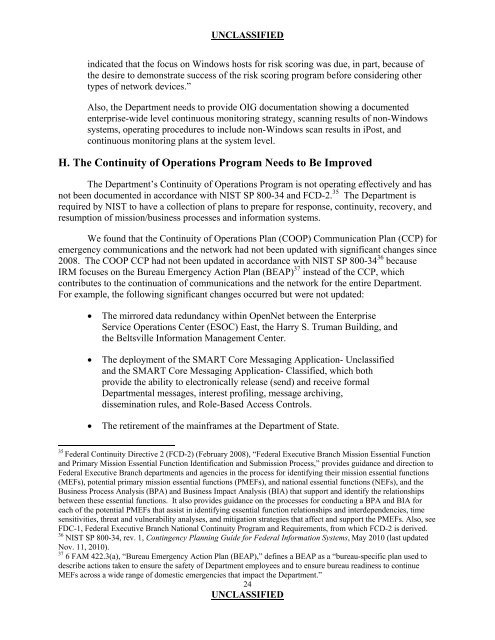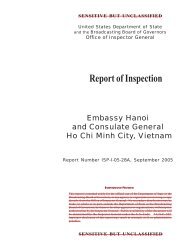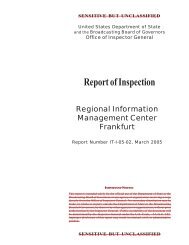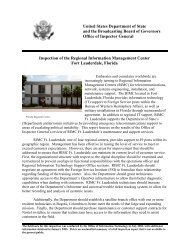Evaluation of Department of State Information Security Program ...
Evaluation of Department of State Information Security Program ...
Evaluation of Department of State Information Security Program ...
You also want an ePaper? Increase the reach of your titles
YUMPU automatically turns print PDFs into web optimized ePapers that Google loves.
UNCLASSIFIED<br />
indicated that the focus on Windows hosts for risk scoring was due, in part, because <strong>of</strong><br />
the desire to demonstrate success <strong>of</strong> the risk scoring program before considering other<br />
types <strong>of</strong> network devices.”<br />
Also, the <strong>Department</strong> needs to provide OIG documentation showing a documented<br />
enterprise-wide level continuous monitoring strategy, scanning results <strong>of</strong> non-Windows<br />
systems, operating procedures to include non-Windows scan results in iPost, and<br />
continuous monitoring plans at the system level.<br />
H. The Continuity <strong>of</strong> Operations <strong>Program</strong> Needs to Be Improved<br />
The <strong>Department</strong>’s Continuity <strong>of</strong> Operations <strong>Program</strong> is not operating effectively and has<br />
not been documented in accordance with NIST SP 800-34 and FCD-2. 35 The <strong>Department</strong> is<br />
required by NIST to have a collection <strong>of</strong> plans to prepare for response, continuity, recovery, and<br />
resumption <strong>of</strong> mission/business processes and information systems.<br />
We found that the Continuity <strong>of</strong> Operations Plan (COOP) Communication Plan (CCP) for<br />
emergency communications and the network had not been updated with significant changes since<br />
2008. The COOP CCP had not been updated in accordance with NIST SP 800-34 36 because<br />
IRM focuses on the Bureau Emergency Action Plan (BEAP) 37 instead <strong>of</strong> the CCP, which<br />
contributes to the continuation <strong>of</strong> communications and the network for the entire <strong>Department</strong>.<br />
For example, the following significant changes occurred but were not updated:<br />
� The mirrored data redundancy within OpenNet between the Enterprise<br />
Service Operations Center (ESOC) East, the Harry S. Truman Building, and<br />
the Beltsville <strong>Information</strong> Management Center.<br />
� The deployment <strong>of</strong> the SMART Core Messaging Application- Unclassified<br />
and the SMART Core Messaging Application- Classified, which both<br />
provide the ability to electronically release (send) and receive formal<br />
<strong>Department</strong>al messages, interest pr<strong>of</strong>iling, message archiving,<br />
dissemination rules, and Role-Based Access Controls.<br />
� The retirement <strong>of</strong> the mainframes at the <strong>Department</strong> <strong>of</strong> <strong>State</strong>.<br />
35<br />
Federal Continuity Directive 2 (FCD-2) (February 2008), “Federal Executive Branch Mission Essential Function<br />
and Primary Mission Essential Function Identification and Submission Process,” provides guidance and direction to<br />
Federal Executive Branch departments and agencies in the process for identifying their mission essential functions<br />
(MEFs), potential primary mission essential functions (PMEFs), and national essential functions (NEFs), and the<br />
Business Process Analysis (BPA) and Business Impact Analysis (BIA) that support and identify the relationships<br />
between these essential functions. It also provides guidance on the processes for conducting a BPA and BIA for<br />
each <strong>of</strong> the potential PMEFs that assist in identifying essential function relationships and interdependencies, time<br />
sensitivities, threat and vulnerability analyses, and mitigation strategies that affect and support the PMEFs. Also, see<br />
FDC-1, Federal Executive Branch National Continuity <strong>Program</strong> and Requirements, from which FCD-2 is derived.<br />
36<br />
NIST SP 800-34, rev. 1, Contingency Planning Guide for Federal <strong>Information</strong> Systems, May 2010 (last updated<br />
Nov. 11, 2010).<br />
37<br />
6 FAM 422.3(a), “Bureau Emergency Action Plan (BEAP),” defines a BEAP as a “bureau-specific plan used to<br />
describe actions taken to ensure the safety <strong>of</strong> <strong>Department</strong> employees and to ensure bureau readiness to continue<br />
MEFs across a wide range <strong>of</strong> domestic emergencies that impact the <strong>Department</strong>.”<br />
24<br />
UNCLASSIFIED








